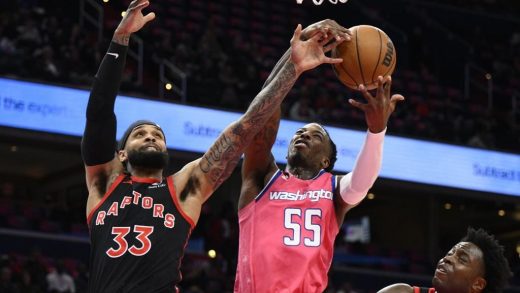
The early returns on the NFL’s new kickoff rules are in from the preseason and the result is a significant increase in returns.
Owners voted this spring to overhaul the kickoff, hoping to revive a play that had little action last season after most kicks resulted in no returns while still prioritizing player safety.
So far, so good, but the real test will come once the regular season starts.

The league was pleased with a return rate of 70.5% in the preseason, up significantly from last season’s 54.8% in exhibition games. There were also more big returns and better average starting field position, which could increase scoring after a drop last season to the lowest level since 2017.
Owners also approved other rule changes, including banning the use of the “ swivel hip-drop” tackle that had led to several injuries and in an increase in the use of instant replay.
The new rules get their first chance to be used in a game that counts on Thursday night when defending champion Kansas City opens the season against Baltimore.
Here’s an explanation of some of the rules that will be in place.
How will kickoffs look different?
Owners agreed to a one-year trial of a radical change on kickoffs with a new system that borrows heavily from what was used in the XFL spring league.
The changes were made in hopes of limiting the high-speed collisions that made kickoffs so dangerous while incentivizing more returns after a sharp rise in touchbacks in recent years.
Standard kicks will still begin from the 35 but everything else will look different.
The 10 kick coverage players will line up at the opposing 40, with five on each side of the field.
The return team will have at least nine blockers lined up in the “set up zone” between the 30- and 35-yard line with at least seven of those players touching the 35. Up to two returners will be allowed inside the 20.
Only the kicker and two returners will be allowed to move until the ball hits the ground or is touched by a returner inside the 20.
Any kick that reaches the end zone in the air can be returned, or the receiving team can opt for a touchback and possession at the 30. Any kick that reaches the end zone in the air and goes out of bounds or out of the end zone also will result in a touchback at the 30.
If a ball hits a returner or the ground before the end zone and goes into the end zone, a touchback will be at the 20 or the kick can be returned. Any kick received in the field of play must be returned.
If a kick goes out of bounds before the end zone, or hits the ground or is touched by the receiving team before reaching the landing zone, the return team gets the ball at the 40.
There will also be no surprise onside kicks. The only ones allowed will be in the fourth quarter with the trailing team declaring its intention before the play, Those will be conducted under the same rules that had previously been in place.
Why did the NFL make the change?
Kickoff returns were becoming obsolete after a series of rule changes to make them safer over the past several seasons.
Last season led to a new low with just 21.8% of all kicks being returned as both kicking and receiving teams too often opted to avoid the risk of a possible return.
The return rate had a significant drop from 37.5% in 2022 and is down from 80% in 2010 before a series of rule changes on alignment, blocking techniques and the touchback eroded those numbers. The NFL projects that more than half of all kickoffs will be returned this season without increasing the risk of injuries.
How did it look in preseason?
With more returns and a bigger penalty for touchbacks, the average starting field position on kickoffs was the 28.8 yard line, an increase of 4.6 yards from the 2023 preseason.
There was also in increase in long returns, with the 18 returns of at least 40 yards the most since the 2014 preseason despite most teams holding back any wrinkles until games that count.
With the average start line so close to the 30, there is a fear that kicking teams might opt to kick deep for touchbacks to avoid the risk of allowing a long return. The NFL opted not to use the XFL starting point of the 35 following touchbacks for the one-year trial but might be motivated to make a change next season if the touchback rate remains too high.
Kicking teams had the most success with kicks that landed between the 5 and the goal line with an average start of the 27.4 yard line. Short kicks fielded outside the 10 led to an average start at the 30.3.
Hip-drop tackles
The other big rule change was the ban on a dangerous type of tackle called the “swivel hip drop.”
NFL executive Jeff Miller said the tackle was used 230 times last season and resulted in 15 players missing time with injuries. It will now result in a 15-yard personal foul penalty if officials spot it on the field, or fines the following week.
A violation will occur if a defender “grabs the runner with both hands or wraps the runner with both arms and unweights himself by swiveling and dropping his hips and/or lower body, landing on and trapping the runner’s leg(s) at or below the knee.”
Miller said there were two possible infractions spotted in the first two weeks of the preseason, with neither called as a penalty on the field. Miller said he was not concerned the penalties weren’t called with the goal being eliminating them through warnings, educations and fines.
Other changes
Some of the other notable changes this season involve tweaks to the instant replay system. Teams now get a third challenge if one of their first two challenges is successful — instead of both — and a few more types of plays are subject to replay. There were less than a dozen games in the regular season and playoffs last season when a coach used both challenges and was successful on only one.
Replay can now determine whether a snap got off before the game clock expired, can advise officials on the field on certain elements of roughing the passer and intentional grounding and can overrule an incorrect call on the field that a passer was down or out of bounds before throwing a pass.
___
AP NFL: https://apnews.com/hub/nfl


